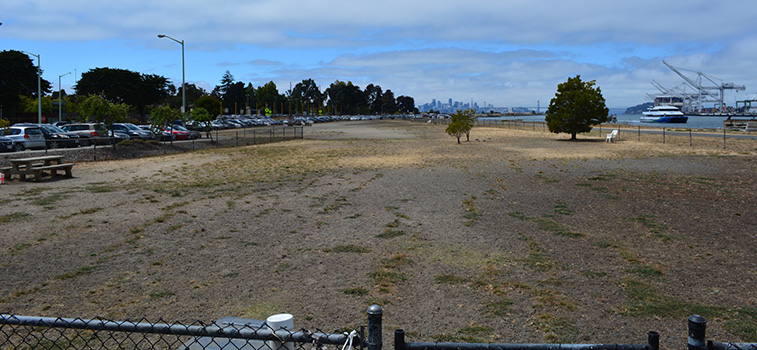Ferry riders driving to Alameda's Main Street Ferry Terminal on the Oakland Estuary found an extra parking lot waiting for them in May.

With ferry ridership continually increasing, parking capacity at Alameda’s Main Street Ferry Terminal remains a problem. A possible solution would be to relocate a nearby dog park and convert it to additional parking. Photo by Richard Bangert
By Richard Bangert
Published: October, 2016
Ferry riders driving to Alameda’s Main Street Ferry Terminal on the Oakland Estuary found an extra parking lot waiting for them in May. The city-owned O Club parking lot across the street from the terminal provides 121 spaces under a temporary agreement with the Water Emergency Transportation Authority (WETA). Despite the added parking lot, the street shoulder and unpaved lot west of a dog park continue to absorb overflow.
“Ridership has grown 29 percent since May, the month we opened the lot,” said Kevin Connolly, WETA’s manager of planning and development. “Given that the street and dirt lot were basically full at that time, it makes sense that the O Club has absorbed the additional riders.”
A ferry access study conducted by WETA in 2014 led to the O Club interim parking solution. The option of converting the nearby dog park to ferry parking was put on hold until the dog park could be moved a mile away to the planned Estuary Park near Alameda Landing.
Dog owners interviewed recently at the Main Street dog park don’t see why the area they use for exercising their dogs should be blocking expansion of ferry parking. “I believe that it would be a better use of taxpayer money by relocating this dog park and turning it into a parking structure,” said Jennifer Keene, who lives near the Bay Farm Bridge. Keene drives across the island because it’s less crowded than Alameda’s other dog park.
“I really like the idea of moving this dog park to Estuary Park because it has a lot more trees, and it’s a better area for the dogs,” said Madison Walzberg, a resident of Coast Guard Housing. “It doesn’t take much to make a dog park. If they just fence it in, it would be a great solution for anyone with dogs,” said Walzberg.
Construction work on the first phase of Estuary Park on Mosley Avenue, featuring sports fields, began in August. Phase 2 of park construction, featuring an open meadow, picnic area and dog park, has yet to be funded. This four-acre section is already fenced in on three sides and could serve as an interim dog park by adding fencing to the remaining 500 feet along the street, according to Walzberg.
The demand for added ferry service at the Main Street Terminal prompted WETA to add five additional weekday departures last year. The enhanced service was set to expire this fall, but WETA will be extending the enhanced service through the end of 2017, thanks to a grant from the Metropolitan Transportation Commission.
In her report to the board of directors in August, WETA Executive Director Nina Rannells said that the enhanced service would coincide with the delivery of two new ferry vessels, the Cetus and the Hydrus, in early 2017. Both vessels will have capacity for 399 passengers and up to 50 bicycles. “The new vessels represent a significant improvement over today’s operations, where average capacity is 324 seats and bikes are sometimes limited to 30 spaces,” said Rannells.
Combined ridership for the Oakland and Alameda Main Street terminals increased by 18,234 passengers from July 2015 to July 2016, representing an increase of 15.69 percent. The systemwide increase for the same period was 7.78 percent.
“All the parking spots get full very early, and you have to fight for a spot,” said Keene. “They park all the way down the road past the nursery, and that’s kind of a hazard, especially early in the morning or late in the evening trying to cross the street.” Keene said that she would gladly pay to “park in a legit parking structure.”
Dog owner Jeff Anderer, a resident of Marina Village, said he uses both dog parks but does not use the ferry. “I come to this dog park on the warmer days for the sea breeze,” said Anderer. “Strictly speaking as a dog owner and not as a ferry user, I do think the parking is more important.”
Asked about costs for expanded parking, Connolly said, “That’s something we will be studying in the coming year or two as part of a comprehensive look at Main Street and its capital needs.”
Richard Bangert posts stories and photos on his blog, Alameda Point Environmental Report.

